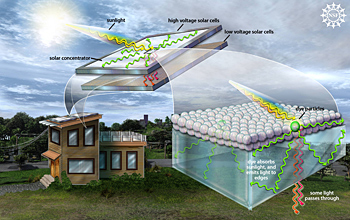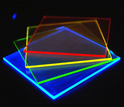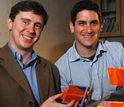News Release 08-118
A Colorful Approach to Solar Energy
Dyed-glass breakthrough channels energy into solar cells

An artist's representation shows a cost-effective solar concentrator.
July 10, 2008
View a video interview of electrical engineer Marc Baldo of MIT.
This material is available primarily for archival purposes. Telephone numbers or other contact information may be out of date; please see current contact information at media contacts.
Revisiting a once-abandoned technique, engineers at the Massachusetts Institute of Technology (MIT) have successfully created a sophisticated, yet affordable, method to turn ordinary glass into a high-tech solar concentrator.
The technology, which uses dye-coated glass to collect and channel photons otherwise lost from a solar panel's surface, could eventually enable an office building to draw energy from its tinted windows as well as its roof.
Electrical engineer Marc Baldo, his graduate students Michael Currie, Jon Mapel and Timothy Heidel, and postdoctoral associate Shalom Goffri, announced their findings in the July 11 issue of Science.
"We think this is a practical technology for reducing the cost of solar power," said Baldo.
The researchers coated glass panels with layers of two or more light-capturing dyes. The dyes absorbed incoming light and then re-emitted the energy into the glass, which served as a conduit to channel the light to solar cells along the panels' edges. The dyes can vary from bright colors to chemicals that are mostly transparent to visible light.
Because the edges of the glass panels are so thin, far less semiconductor material is needed to collect the light energy and convert that energy into electricity.
"Solar cells generate at least ten times more power when attached to the concentrator," added Baldo.
Because the starting materials are affordable, relatively easy to scale up beyond a laboratory setting, and easy to retrofit to existing solar panels, the researchers believe the technology could find its way to the marketplace within three years.
The new technology emerged in part from an NSF Nanoscale Interdisciplinary Research Team effort to transfer the capabilities of photosynthesis to solar technology.
The researchers' approach succeeded where efforts from the 1970s failed because the thin, concentrated layer of dyes on glass is more effective than the alternative--a low concentration of dyes in plastic--at channeling most of the light all the way to the panel edges. However, the current technology still needs further development to create a system that will last the 20- to 30-year lifetime necessary for a commercial product.
For additional information, see the MIT release at: http://web.mit.edu/newsoffice/2008/solarcells-0710.html
-NSF-
-
View Video
Marc Baldo explains a breakthrough solar concentrator he developed with students and collaborators.
Credit and Larger Version -
Organic solar concentrators collect and focus different colors of sunlight.
Credit and Larger Version -
Marc Baldo and Shalom Goffri, both of MIT, hold examples of organic solar concentrators.
Credit and Larger Version -
The researchers' findings are announced in the July 11 issue of Science magazine.
Credit and Larger Version
Media Contacts
Joshua A. Chamot, NSF, (703) 292-7730, email: jchamot@nsf.gov
Teresa Herbert, Massachusetts Institute of Technology, (617) 258-5403, email: therbert@MIT.EDU
Program Contacts
Rajinder Khosla, NSF, (703) 292-8339, email: rkhosla@nsf.gov
Principal Investigators
Marc Baldo, Massachusetts Institute of Technology, (617) 452-5132, email: baldo@MIT.EDU
The U.S. National Science Foundation propels the nation forward by advancing fundamental research in all fields of science and engineering. NSF supports research and people by providing facilities, instruments and funding to support their ingenuity and sustain the U.S. as a global leader in research and innovation. With a fiscal year 2023 budget of $9.5 billion, NSF funds reach all 50 states through grants to nearly 2,000 colleges, universities and institutions. Each year, NSF receives more than 40,000 competitive proposals and makes about 11,000 new awards. Those awards include support for cooperative research with industry, Arctic and Antarctic research and operations, and U.S. participation in international scientific efforts.
Connect with us online
NSF website: nsf.gov
NSF News: nsf.gov/news
For News Media: nsf.gov/news/newsroom
Statistics: nsf.gov/statistics/
Awards database: nsf.gov/awardsearch/
Follow us on social
Twitter: twitter.com/NSF
Facebook: facebook.com/US.NSF
Instagram: instagram.com/nsfgov




